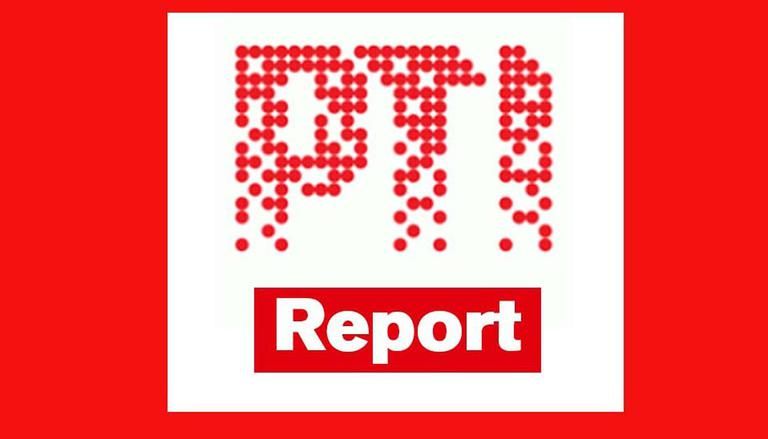Seoul, Jan 11 (AP) North Korea says leader Kim Jong Un oversaw a successful flight test of a hypersonic missile he claimed would remarkably increase the country’s nuclear “war deterrent.” The report by North Korean state media on Wednesday came a day after the militaries of the United States, South Korea and Japan said they detected North Korea firing a suspected ballistic missile into its eastern sea.
The Korean Central News Agency said Tuesday’s launch involved a hypersonic glide vehicle, which after its release from the rocket booster demonstrated “glide jump flight” and “corkscrew maneuvering” before hitting a sea target 1,000 kilometers (621 miles) away.
Photos released by the agency showed a missile mounted with a pointed cone-shaped payload soaring into the sky while leaving a trail of orange flames and Kim watching from a small cabin with top officials.
The launch was North Korea’s second test of its purported hypersonic missile in a week, a type of weaponry it first tested in September, as Kim continues a defiant push to expand his nuclear weapons capabilities in the face of international sanctions, pandemic-related difficulties and deadlocked diplomacy with the United States.
The North has been ramping up its testing activity since last fall in what experts see as an attempt to apply more pressure on rivals Washington and Seoul to accept it as a nuclear power in hopes of winning relief from economic sanctions.
The KCNA said Kim praised the accomplishments made by his military scientists and officials involved in developing the hypersonic missile system, which he described as the most significant part of a new five-year plan announced in early 2021 to build up the North’s military force.
The North has described the new missile as part of its “strategic” weaponry, implying that the system is being developed to deliver nuclear weapons.
Hypersonic weapons, which fly at speeds in excess of Mach 5, or five times the speed of sound, could pose a crucial challenge to missile defense systems because of their speed and maneuverability. Such weapons were on a wish-list of sophisticated military assets Kim unveiled early last year along with multi-warhead missiles, spy satellites, solid-fuel long-range missiles and submarine-launched nuclear missiles.
Experts say North Korea is likely years away from acquiring a credible hypersonic system. But Kim’s attendance at Tuesday’s launch and the state media’s description of it as a “final test-fire” indicated that the North was possibly moving toward deploying the weapon relatively soon.
“The superior maneuverability of the hypersonic glide vehicle was more strikingly verified through the final test-fire,” KCNA said.
It said Kim stressed the need to speed up the expansion of the country’s “strategic military muscle both in quality and quantity and further modernize the army” and encouraged military scientists to continue their success in “remarkably increasing the war deterrent of the country.” US State Department spokesman Ned Price said Washington condemns the North’s latest launch, which violates multiple UN Security Council resolutions and poses a threat to neighbours and to the broader international community.
The US Indo-Pacific Command said the launch highlighted the “destabilizing impact of (North Korea’s) illicit weapons program” but didn’t pose an immediate threat to US territory or its allies.
“We continue to call on the DPRK to refrain from further provocations and, importantly, to engage in sustained and substantive dialogue,” Price said, using an abbreviation of North Korea’s formal name, the Democratic People’s Republic of Korea.
South Korea’s Joint Chiefs of Staff had said the North Korean missile flew 700 kilometers (434 miles) at a maximum speed of around Mach 10 before landing in waters off the North’s eastern coast.
South Korea’s Defense Ministry had played down North Korea’s earlier test on January 5, insisting that the North exaggerated its capabilities after testing a conventional ballistic missile and expressing doubt that the North had acquired the technologies needed for hypersonic weapons.
Following Tuesday’s launch, the Joint Chief of Staff said in a statement that the North demonstrated more advanced capability compared to its previous test, but didn’t elaborate further.
Kim entered the new year renewing his vow to bolster his military forces, even as the nation grapples with pandemic-related difficulties that have further strained its economy, crippled by US-led sanctions over its nuclear program.
The economic setbacks have left Kim with little to show for his diplomacy with former US President Donald Trump, which derailed after their second meeting in 2019 when the Americans rejected North Korea’s demand for major sanctions relief in exchange for a partial surrender of its nuclear capabilities.
The Biden administration, whose policies have reflected a broader shift in US focus from counterterrorism and so-called rogue states like North Korea and Iran to confronting a near-peer adversary in China, has said it’s willing to resume talks with North Korea “anywhere and at any time” without preconditions.
But North Korea has so far rejected the idea of open-ended talks, saying the US must first withdraw its “hostile policy,” a term the North mainly uses to describe the sanctions and joint US-South Korea military drills. (AP) CPS
(Disclaimer: This story is auto-generated from a syndicated feed; only the image & headline may have been reworked by www.republicworld.com)
